A death cross is a market signal you should watch for. It happens when the 50-day moving average falls below the 200-day moving average, suggesting a shift from bullish to bearish trends. This pattern often surfaces after an asset peaks, indicating potential market weakness and increased selling pressure. While it can warn you of possible downturns, it's considered a lagging indicator, meaning you'll want to use it alongside other metrics for better accuracy. Understanding the implications of a death cross can enhance your trading strategies, so stick around to uncover more insights on this crucial market phenomenon.
Key Takeaways
- A death cross occurs when the 50-day moving average crosses below the 200-day moving average, signaling potential bearish trends.
- It typically indicates a shift from bullish to bearish market sentiment, often appearing near an asset's local peak.
- The death cross is a lagging indicator, requiring confirmation from other metrics like RSI or MACD for accurate interpretation.
- Historically, it has preceded significant market declines, reflecting increased selling pressure and investor pessimism.
- Traders use the death cross for setting short positions while emphasizing risk management and monitoring volume for confirmation.
Market Indicator Explanation
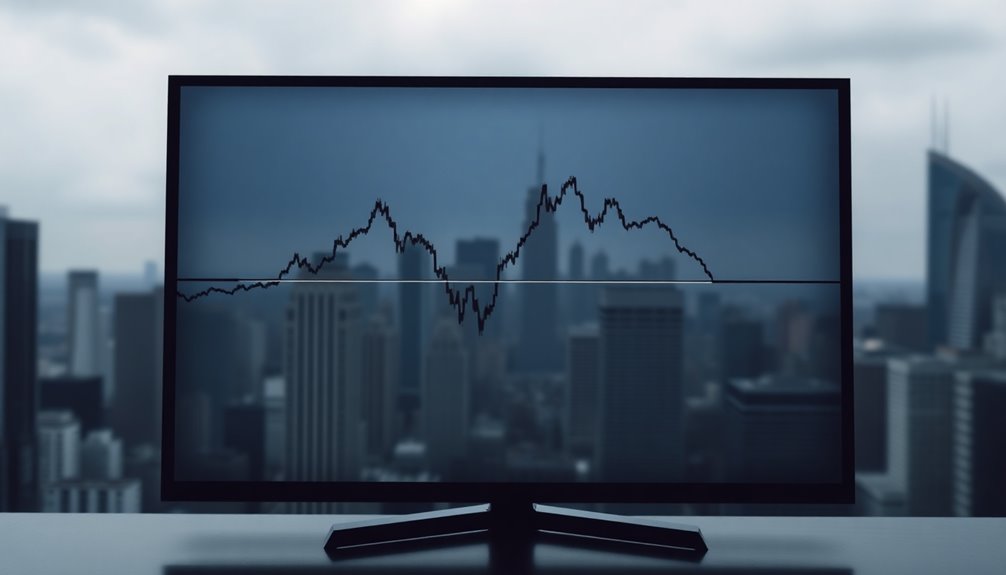
The death cross is a crucial market indicator that traders watch closely. It occurs when the 50-day moving average crosses below the 200-day moving average, signaling a potential shift from an uptrend to a downtrend.
This formation typically appears near an asset's local peak, suggesting market weakness. As a lagging indicator, it reflects past performance, so you'll want to confirm it with other metrics like RSI or MACD for reliability. The death cross is often seen as a reliable indicator for potential market downturns, particularly following a prolonged bullish phase.
The crossover creates an X-shape on charts, enhancing its visibility. Remember, while the death cross can indicate a decline in short-term momentum and hint at bearish trends, it can also produce false signals.
Keeping an eye on trading volumes during the crossover can add validity to the signal.
Market Sentiment and Trends
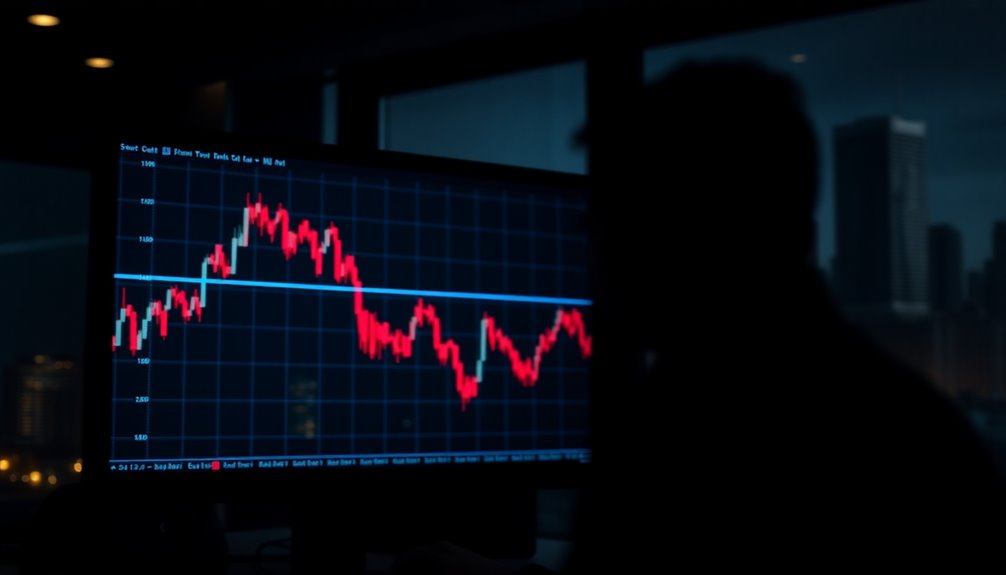
While traders closely monitor the death cross for signals of market shifts, understanding the broader market sentiment is essential.
This crossover signifies a shift from optimism to pessimism, marking the end of bullish momentum and the start of bearish trends. As market optimism fades, uncertainty creeps in, often triggering panic selling. You'll notice that the death cross typically appears in previously uptrending markets, hinting at a potential reversal. It indicates that short-term declines are outpacing long-term trends, reflecting market weakness. A confirmed death cross can serve as a strong signal for short-selling strategies, emphasizing the urgency for traders to adjust their positions.
Historically, such patterns have preceded severe bear markets, signaling the need for caution. By grasping these sentiment changes, you can better navigate potential corrections or downtrends, ensuring your trading strategies align with the evolving market landscape.
Signal of Bearish Momentum
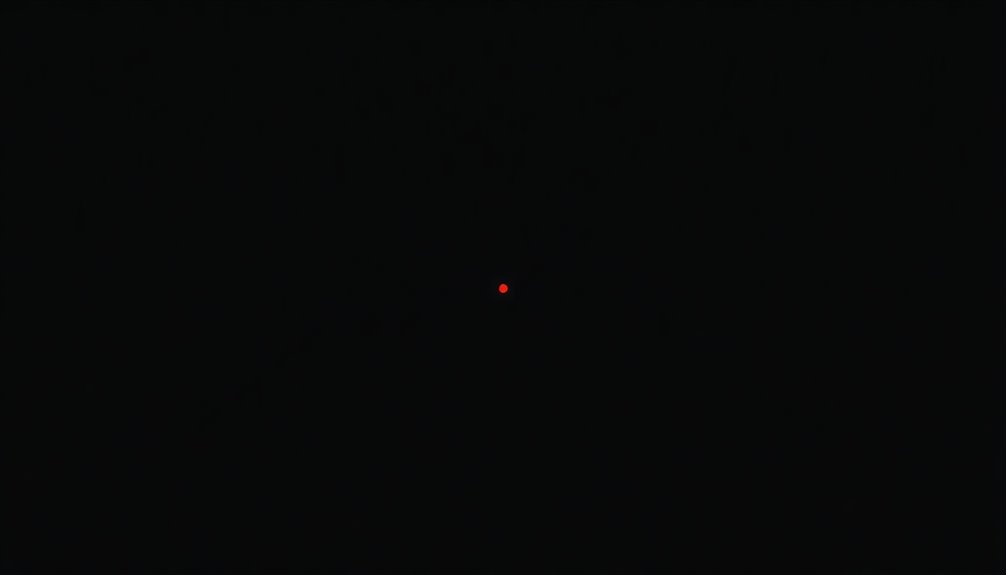
Market sentiment often shifts dramatically when a death cross occurs, signaling a clear indication of bearish momentum. This crossover happens when the 50-day moving average dips below the 200-day moving average, marking a potential trend reversal from bullish to bearish.
It's interpreted as a strong bearish signal, highlighting market weakness and increasing selling pressure. As a trader, you might see this as a chance for short-selling, or as a warning to trim your long positions. The death cross is often considered a late indicator due to its reliance on historical data, which can produce false signals. Confirming this signal with other indicators is crucial, as not every death cross leads to a prolonged downtrend. Keep in mind that while historically significant, false signals can occur, so always approach with caution.
Pros and Cons Overview

Evaluating the death cross reveals a mix of advantages and drawbacks that traders should consider.
On the plus side, it indicates a potential long-term trend change and can help reduce portfolio volatility by allowing you to sell before major market crashes. It's also easy to identify on charts and has a historical track record of predicting significant downturns, as seen in the 2007 S&P 500 death cross.
However, it's important to recognize its limitations. As a lagging indicator, it often signals changes after they've already occurred. Additionally, it can generate false signals in volatile markets, so confirming it with other indicators is crucial.
Lastly, relying solely on the death cross might lead to missed opportunities for early trend reversals. Balancing these pros and cons is essential for informed trading decisions.
Death Cross vs. Golden Cross

The stark contrast between the death cross and golden cross serves as a crucial guide for traders navigating market trends.
A death cross occurs when the 50-day moving average dips below the 200-day moving average, signaling a bearish trend. This pattern suggests negative sentiment and potential downward movement, often confirming a change that's already underway. Historically, the death cross has often preceded significant market downturns, highlighting its importance as a trend indicator.
In contrast, a golden cross forms when the 50-day moving average rises above the 200-day moving average, indicating a bullish trend and positive market sentiment.
Both patterns gain significance when accompanied by high trading volume. Traders utilize these signals to inform their decisions—considering short-selling during a death cross and identifying buying opportunities during a golden cross.
Understanding these indicators is essential for effective trading strategies.
Market Volatility Implications
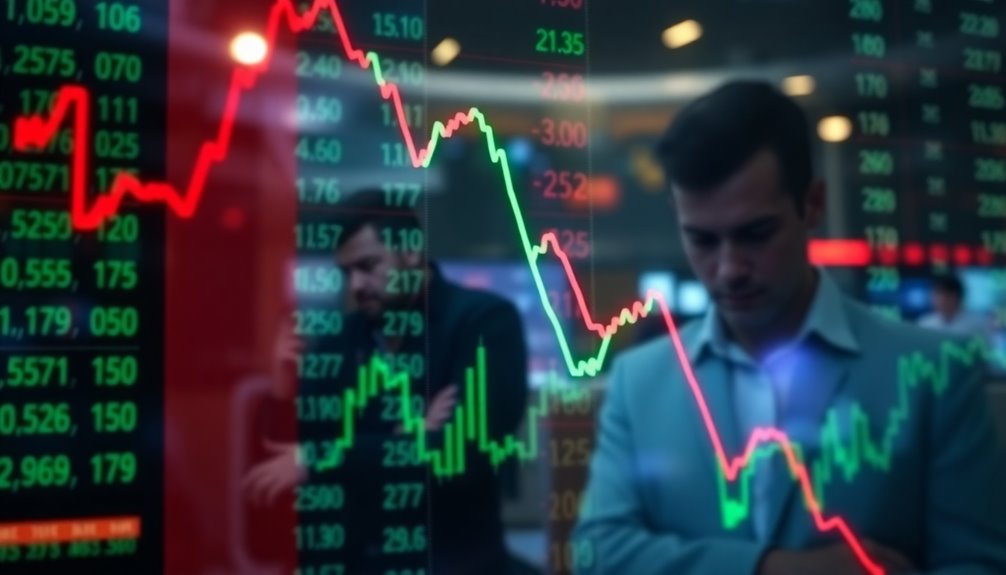
When a death cross appears, it often triggers heightened market volatility that can significantly impact your trading strategy.
You might notice a shift in market momentum, as this pattern signals a downturn, often transitioning from an uptrend to a downtrend. Short-term price declines may outpace long-term trends, reflecting a broader sentiment shift from optimism to uncertainty. This can lead to increased sell-offs, as investors exit their positions in response to heightened fear. Historically, markets underperform in the months following a death cross, with deeper drawdowns and greater volatility, as evidenced by the fact that the average MaxDD after death crosses is -12.3% average MaxDD.
Be prepared for a more cautious approach, as the risks associated with trading during these periods can lead to prolonged declines and economic distress.
Recent Market Behavior Analysis
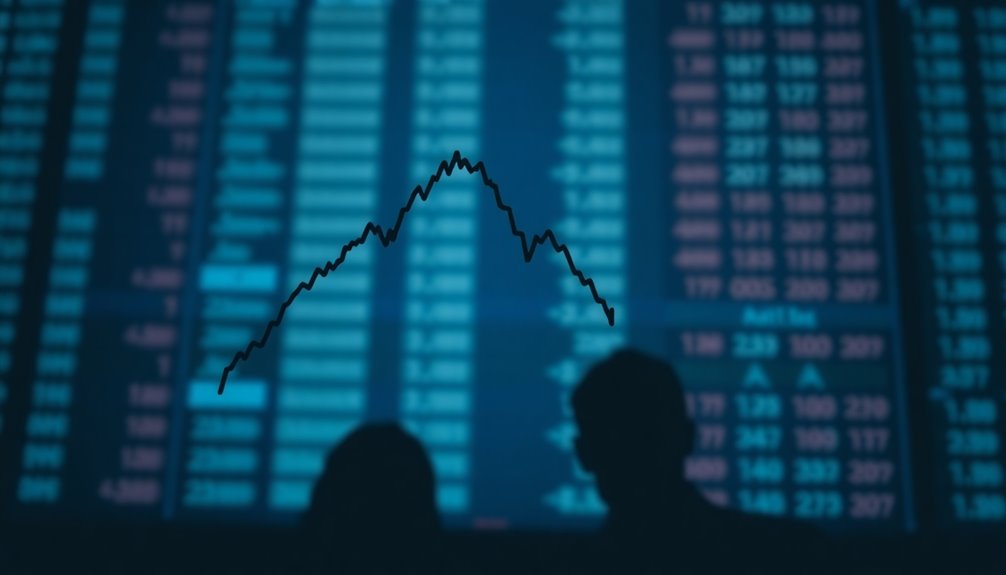
In light of recent market movements, analyzing how the death cross has influenced trader sentiment and behavior becomes vital. Historically, this pattern has preceded severe bear markets, but it doesn't always signal such downturns. You might notice that the S&P 500 often rebounds post-death cross, with about two-thirds of instances showing gains after a year. Short-term reactions vary; prices can continue declining or even reverse. The Nasdaq Composite, for instance, has shown positive average returns following a death cross, with returns averaging 2.6% (1 month) after the occurrence. As a trader, you should be cautious and look for confirmation before acting on this signal. Ultimately, understanding the broader context helps you make informed decisions and avoid potential pitfalls in your trading strategy.
Monitor Volume Changes Closely
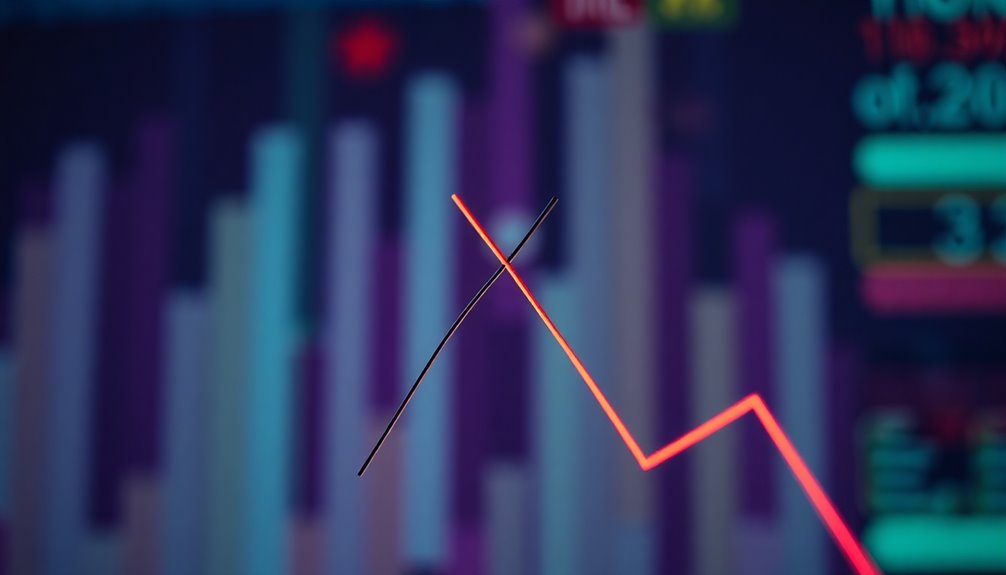
Monitoring volume changes closely can significantly enhance your trading strategy, especially during a death cross. High volume during this event indicates strong selling pressure, making the signal more reliable. If you notice a significant increase in volume as the 50-day MA crosses below the 200-day MA, it suggests sustained downward momentum. Conversely, low volume might signal a false cross, meaning the trend could reverse soon. By combining volume analysis with other indicators like moving averages, you can validate the bearish trend. This approach helps you set up trades more effectively, manage risk through appropriate stop-loss placements, and gauge market sentiment. Additionally, the death cross has historically indicated potential declines, reinforcing the importance of monitoring volume during this critical crossover.
Frequently Asked Questions
How Can I Identify a Death Cross on a Chart?
To identify a death cross on a chart, look for the 50-day moving average crossing below the 200-day moving average.
This crossover usually signals a shift from a bullish to a bearish trend.
You'll want to ensure you're viewing the right time frame, like daily or weekly.
Once you spot the crossover, pay attention to market volume, as increased trading can confirm the downward trend.
Make sure to act quickly!
What Timeframes Are Best for Analyzing a Death Cross?
When analyzing a death cross, daily charts are your best bet; studies show they provide a clearer picture of market trends.
The 50-day and 200-day moving averages used in this timeframe have a high probability of success.
Avoid shorter timeframes, as they often lead to false signals and market noise.
Are There Historical Examples of Successful Death Crosses?
Yes, there are historical examples of successful death crosses that preceded significant market downturns.
For instance, in 1929, a death cross signaled the start of the Great Depression, leading to a decade-long bear market.
Similarly, the 2008 financial crisis saw a death cross form before the housing market crash.
These instances highlight how recognizing such signals can help you navigate turbulent market conditions, but remember, they're not foolproof and can sometimes yield false positives.
How Often Do Death Crosses Lead to Actual Market Declines?
Interestingly, about two-thirds of the time, the S&P 500 rises a year after a death cross.
While death crosses can trigger short-term declines, they don't always lead to sustained market downturns. In fact, historical data shows that gains often follow these signals.
Can Death Crosses Occur in Other Markets Besides Stocks?
Yes, death crosses can occur in various markets besides stocks.
You'll find them in commodities, cryptocurrencies, and even foreign exchange markets. Each market may interpret the signals differently, but the underlying principle remains the same: a bearish trend is indicated when a shorter-term moving average crosses below a longer-term one.
While they can provide insights, remember to use them alongside other indicators to strengthen your analysis and avoid potential pitfalls.
Conclusion
In summary, the death cross might sound ominous, but it's just a signal to stay alert. When you see this market indicator, it's a gentle reminder to reassess and adapt your strategy. While it can hint at bearish trends, it also opens doors to new opportunities. By keeping an eye on market behavior and volume changes, you can navigate the waves of volatility with confidence. Embrace the journey; it's all part of the trading adventure!









